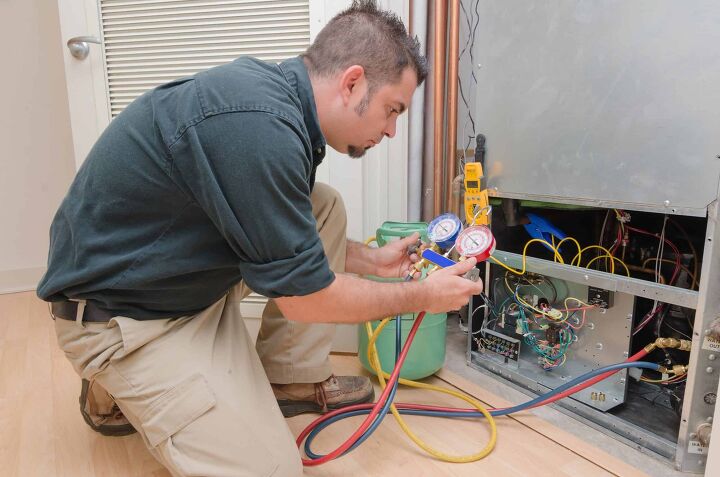How To Bypass The Start Relay On A Refrigerator

Try to list off the appliances you have at home that you consider absolutely essential. It likely won’t take long before you list the refrigerator. Even just imagining what could happen if the refrigerator breaks down can be stressful for many homeowners.
Unfortunately, a refrigerator breaking down is not a rare occurrence. One common issue that can plague homeowners is a failing start relay. You can do something about that issue though, even if it is a temporary fix.
To bypass the start relay on a refrigerator you will need to remove the relay system and rework the connections by removing the wires, stripping them, and restoring the circuit using electrical tape. To gain access to the relay system, remove the cover plate and the metal box with a flathead screwdriver.
The entire process can be complicated and is not without risk. You’ll need to try it out yourself if you want your refrigerator working properly again though. Eventually, you’ll also have to request help from the professionals.
Find out more about the relay system and how it affects your refrigerator. You can also read on to learn more about the telltale signs of a busted refrigerator relay.
Do You Need Appliance Installation or Replacement?
Get free, zero-commitment quotes from pro contractors near you.

What Is the Importance of the Refrigerator Relay?
Before we can discuss the refrigerator relay, it’s important to know more about the compressor first. The compressor is a vital component of the machine. It’s responsible for moving the refrigerant throughout the whole appliance as it works as both a motor and a pump.
Notably, the refrigerator’s compressor is not active all the time. If it was, the refrigerator would not settle at your preferred temperature level. Sensors inside the refrigerator will tell the compressor when to start working in order to achieve the right level of cooling.
This is where the relay becomes important. The main job of the relay system is to kick the refrigerator’s compressor into gear. It’s even responsible for telling the compressor when to shut down.
Simply put, a malfunctioning relay system will lead to the entire refrigerator not working as intended. Foods you have stored may start to spoil if you don’t do something sooner rather than later. That’s why you should also pay close attention to your refrigerator relay.
The Symptoms of a Broken Refrigerator Relay System
You don’t have to be an expert on refrigerators to figure out that something’s wrong with the relay. Some of the signs are pretty easy to detect and you should be able to identify them on your own.
The Contents of the Refrigerator Are Not Cooled Down
Want to know if something’s wrong with your refrigerator’s relay system? Smart Kitchen Improvement recommends opening up your refrigerator to perform a quick check. Look at the items inside and check out the contents of the freezer too.
The items inside should obviously be chilled and/or frozen. If they aren’t, that’s probably because the compressor is not working as intended. That issue probably has something to do with the relay system.
You’re Hearing Unusual Clicking Noises
The refrigerator relay usually works pretty covertly, but it does tend to produce a sound. It specifically produces a clicking noise whenever it tells the compressor to start working.
Here’s the thing though: That clicking noise will still pop up even if the relay system is busted. They won’t stop just because the compressor remains disengaged. If anything, the clicking noises will become more frequent as the fridge will keep trying to start the compressor.
Take a closer look at your refrigerator as soon as you start hearing those clicking noises. The clicking noises will be heard after every two to five minutes if the compressor remains inactive.
The Process of Bypassing the Refrigerator’s Relay System
Let’s say that your refrigerator is indeed displaying the symptoms of a broken relay system, what should you do next? You can try to fix things yourself temporarily by following the steps below.
Step 1: Prepare the Tools for the Job
One of the reasons why you can take on this task yourself is because you don’t need specialized tools. You just need a screwdriver, a flathead screwdriver, some electric tape, and a pair of pliers.
Step 2: Ask a Friend for Some Assistance
Refrigerators are heavy and you shouldn’t try moving them on your own. Call a friend over and ask him/her to help with moving the refrigerator.
Step 3: Completely Shut Off the Refrigerator
To get things started, you’ll first have to turn the refrigerator off. Unplug it from the wall and move it to a safe location where you and your friend have space to work.
Step 4: Gain Access to the Refrigerator Relay System
With the refrigerator unplugged, position it now in such a way that you can easily access the bottom portion. You should find a cover plate near the bottom of the refrigerator. Remove that with your screwdriver.
Upon removing the cover plate, you should see a metal box located near the lower right side of the refrigerator. You will have to either push or flex that metal box in order to gain access to the relay system.
Step 5: Remove the Relay
Grab your flathead screwdriver next and use it to press down on the space between the relay and the casing. You should also press down on the relay in order to remove it. Once you’ve taken out the relay, work on removing the metal connectors that are connected to it.
Step 6: Modify the Metal Connectors
Take the metal connectors and start working on them with your pliers. You want to use the pliers to strip back some of the wires on both sides. Strip back about a quarter of an inch on the connectors.
Step 7: Use the Electrical Tape to Restore the Connection
Pick up your roll of electrical tape now and use it to attach the wires to relay housing. Doing so should allow the compressor to turn back on even if the relay system is broken.
Step 8: Restore the Refrigerator
You can now go ahead and return the metal box and the cover plate to their original positions. Plug the refrigerator back in too and see if the fixes have worked.
Do You Need Appliance Installation or Replacement?
Get free, zero-commitment quotes from pro contractors near you.

Related Questions
How Can You Be Certain That a Refrigerator Relay Is Broken?
Upon seeing that your refrigerator is not working properly, you may suspect that it has something to do with the relay. Looking for the symptoms will tell you something’s wrong, but to be certain, you have to perform a test.You can follow the steps above to expose the relay system, but this time, you won’t be bypassing it. Instead, you’ll be testing it.Remove the relay from the refrigerator and then shake it around. A rattling sound coming from the inside of the relay means that there’s something wrong with it. You will have to replace it sooner rather than later.
What Should I Do if the Compressor Is Broken?
Addressing the issue of a faulty refrigerator relay is one thing. Figuring out what to do when the refrigerator’s compressor breaks down is a different matter altogether.You’ll have to either call the professionals to fix that problem or replace your refrigerator. When trying to make that decision, consider what kind of refrigerator you have.More expensive refrigerators that have more features are well worth trying to repair. If you have an older and less expensive model, replacing it could be the more cost-effective option.
How Long Can You Keep the Refrigerator in Bypass Mode?
It’s important to note that keeping your refrigerator in bypass mode is not a permanent fix. Your unit could sustain lasting damage if it’s kept that way for too long.Call on the professionals soon after you put the refrigerator in bypass mode so that the relay can be repaired properly. If the relay system needs to be completely replaced, they will be able to help with that as well.

We are a team of passionate homeowners, home improvement pros, and DIY enthusiasts who enjoy sharing home improvement, housekeeping, decorating, and more with other homeowners! Whether you're looking for a step-by-step guide on fixing an appliance or the cost of installing a fence, we've here to help.
More by Upgraded Home Team











![Finishing Basement Without Permit [Is It Really Illegal?]](https://cdn-fastly.upgradedhome.com/media/2023/07/31/9070078/finishing-basement-without-permit-is-it-really-illegal.jpg?size=350x220)
![The 10 Best Table Saws - [2022 Reviews & Buyer's Guide]](https://cdn-fastly.upgradedhome.com/media/2023/07/31/9070645/the-10-best-table-saws-2022-reviews-buyer-s-guide.jpg?size=350x220)

![The 5 Best Angle Grinders – [2022 Reviews & Buyer's Guide]](https://cdn-fastly.upgradedhome.com/media/2023/07/31/9071326/the-5-best-angle-grinders-2022-reviews-buyer-s-guide.jpg?size=350x220)

![Standard Dining Room Table Dimensions [for 4, 6, 8, 10 and 12 People]](https://cdn-fastly.upgradedhome.com/media/2023/07/31/9074335/standard-dining-room-table-dimensions-for-4-6-8-10-and-12-people.jpg?size=350x220)










